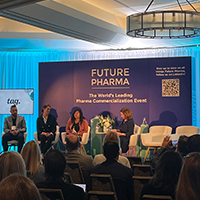Cell and gene therapies: Stagnation or maturation?
The cell and gene therapies (CGTs) of the 2030s – including the way they are manufactured, delivered, and paid for – will and must look very different than they do today. The long, complex development journey, coupled with reimbursement struggles, has led to a lack of funding and investors turning their attention away from the considerable promises of these therapies. But the tide might very well be turning.
Earlier this year, GlobalData announced that the cell and gene therapy market is “poised for exceptional growth at a compound annual growth rate of 44%, with sales projected to rise from $8.70 billion in 2024 to $76.03 billion in 2030.” Indeed, its report, Cell and Gene Therapies in Gastrointestinal Disorders – Therapeutic Analysis, Treatment Options, Pricing and Reimbursement and Future Market, revealed that, “despite the challenges such as the lack of specific targets, pricing, and access barriers […] growth is expected to be driven by two key factors: strong demand from patients seeking curative treatments for their diseases, and widespread interest among both large and small pharma and biotech companies in discovering the next breakthrough transformative drug.”
Here, four experts spoke with Deep Dive to discuss the state of affairs in CGTs, exploring – and arguing with – both notions of stagnation and the maturing possibilities offered by the space.
Not stagnation, but a manufacturing issue
According to Lee Buckler, CGT industry expert and SVP of advanced therapies at Blood Centers of America, the landscape of challenges is a very real sign that something needs to change. But he rejects the word ‘stagnation’ when it comes to CGTs.
“If by stagnation of the cell and gene therapy sector you're referring to the flattening out of sales numbers for commercial CAR-Ts, then I suppose we can speak to that, but I'm not sure it reflects a stagnation of the sector per se,” proposed Buckler.
“The FDA sort of led the charge, I think, among regulatory agencies around the world to create unique regulatory paradigms for cell and gene and tissue therapies, which more or less followed the drug paradigm and created a similar pathway in terms of their clinical testing,” he continued. “We didn't have any products approved for quite some time, and then we had one approved from a little biotech company called Dendreon, which launched the first ever cell-based immunotherapy.”
“Then, we didn't have another one for 10 years, and then we had this explosion of what we call CAR-T cell therapies, which are engineered, a different kind of immune cell, genetically modified,” Buckler said. “And the efficacy was so off the charts […] we ended up with now seven or eight of these CAR-T cell therapies approved for a relatively small bundle of blood cancers, right, and now one of them is approved already as a second line therapy.”
“Fast-forward to where we find ourselves potentially stagnating – if we want to even accept that word – and what we find is that we have these tremendously novel, oftentimes curative therapies available to thousands of patients eligible for these therapies, and we're having difficulty manufacturing enough.”
Pricing, reimbursement, and access
For Buckler, if there is stagnation, it's not by virtue of a shortage of patients or clinical demand for these products; it's everything else. That is to say, the cost, reimbursement ability, manufacturability, and, of course, regulatory approvals.
“We've created curative therapies for which there is insatiable demand,” said Buckler. “An early stage – but very exciting – area of innovation that I'm passionate about is ‘decentralised manufacturing’: if I'm manufacturing a product for you using your cells, it would be far more optimal if I could manufacture that as close to you as possible. I can take blood from you, I can isolate your red blood cells, I can isolate your plasma, I can isolate your platelets. Material collected, processed, isolated, separated, tested, and given back to the hospital for transfusion.”
However, when it comes to price based on cost or value, weighed against quality of life with the potentially curative nature of CGTs, the lifetime treatment and long-term follow-up aspects are difficult to convey in terms of evidence on the current regulatory path.
“How do you cost for a 15-year follow-up or longer?” asked Buckler. “We don't have long-term evidence, yet. One area where we need to continue to invest, [is to] understand exactly what the long-term benefits are, but also potentially the long-term adverse effects. For instance, if you have a gene therapy that's delivered by an AAV, are you then precluded from having any other gene therapy ever again? And what is the cost of that?”
“I think the phrase on everyone's lips today is patient accessibility,” added Buckler. “None of us gets up in the morning to address 20% of the eligible patients, right? We want to bring these therapies to every single eligible patient, whether they're in Los Angeles or Bass, Alabama or Nigeria. We wake up in the morning to ensure that all the progress we've made brings these products to market […and] to every single patient in that market.”
It should be noted on this point that, since speaking with Buckler, the FDA has announced it will be relaxing regulations around first-generation autologous CAR-T therapies targeting CD19 and BCMA, doing away with the risk evaluation and mitigation strategies (REMS) that were a condition of the approval of the cell therapies.
Patient accessibility and collaboration
Veerle D’Haenens – general manager of cell therapy technologies at Terumo Blood and Cell Technologies – sees collaboration as key to achieving improved patient access. Terumo BCT currently partners with several key industry heavyweights to optimise existing manufacturing processes and last year backed the launch of a new stem cell collection centre by the UK charity Anthony Nolan with systems needed to enable collections: the Anthony Nolan Cell Collection Centre in Nottingham, UK.
As Buckler attested to, the remarkable success of CGTs has placed a new pressure on the sites that collect starting material from donors, and the new cell collection centre operates in collaboration with the National Institute for Health and Care Research (NIHR) Nottingham Clinical Research Facility (CRF) at Nottingham University Hospitals NHS Trust, situated at Queen's Medical Centre.
D’Haenens, like Buckler, argued against the term ‘stagnation’, citing ongoing evolution – particularly in autologous CAR-T therapies for autoimmune diseases and solid cancers – as well as increasing investments, therapies in development, and collaborations as evidence of growth. Indeed, D’Haenens emphasised the importance of automation and collaboration to improve therapy access and quality.
“If you look at the number of therapies that are in development, the number of therapy developers is still increasing across the regions, new fields of applications, looking into new modalities, helping those therapies to the markets,” explained D’Haenens. “The full space of cell therapy remains very dynamic and in full expansion, […] so joining forces to create synergies is important […] If we can show, together with other companies, that our automation platforms are able to be built in a CAR-T workflow – if you generate that data and confirm that possibility on your own, I don't think that has the same value.”
“For instance, companies like Vertex, like bluebird bio, that are bringing gene therapies for sickle cell disease to the market – it all starts with the cell collection on our devices, by enabling them to make that more successful, more efficient, reducing the time to make that collection happen in a good way that they can, from that material, produce and manufacture an effective treatment for the end patients,” D’Haenens said.
"The cell and gene therapy ecosystem has long been fragmented, but by focusing on the patient, from cell collection through processing and manufacturing, we harness the power of collaboration across stakeholders,” D’Haenens continued. “Our role in this journey helps us connect the dots, combining our technology and insights with our partners’ expertise, to tackle the challenges of commercialisation and contribute to better patient outcomes.”
A question of targeted dosing and scalability
As a founder and leader of multiple companies in the biopharma sector, Stella Vnook – CEO of Likarda – understands what has driven investment hesitation when it comes to CGTs and knows well what investors need to see to turn this around. Though there has been noticeable and laudable progress within the CGT space, Vnook posited that the time it takes to ‘perfect’ these therapies – for safety and for scalability – has perhaps leant to the ‘stagnation’ notion.
“We have spent a very long time perfecting small batch manufacturing,” she said, “and inlining some of those regulatory compliance issues and then optimising and perfecting that real time software.”
“Generally, these therapies are safe if we use them at the lowest dose possible; the question is [what] the lowest dose possible is,” she explained. “We use technologies like the CAR-Ts, able to encapsulate these therapies through a very complex crosslinking process, in order to deliver it directly to the targeted organ. And because the technology, through its crosslinking, enables the therapy to stay at the target tumour for a prolonged period of time, we're able to reduce the dose intervals and number of cells and assure that it stays there.”
Meanwhile, having guided many developers through their journey to commercialisation, Angela Osborne – CEO of eXmoor Pharma – knows how forward thinking and early process optimisation can help avoid unattainable price points for therapies at commercialisation. Indeed, Osborne believes that the CGT industry has been hugely impacted by a shortage of funding and investment.
“I think the 2023 investment was half of 2021 and, you know, that's just kind of played through,” she said. “I know that 2024 [looked] better, [with] more money going in, but to fewer companies […] The way it's appearing to us is that our clients are delaying their spend and trying to extend their runways as much as possible.”
A delay, as opposed to a firm stagnation, then, but one unfolding over several years. This applies not only to SMEs, but to big pharma, too, in terms of restructuring and refocusing – even in terms of redundancies in some areas of the CGT space.
“There's the kind of macroeconomic climate in which none of us can do anything about this; global unrest, political uncertainty,” explained Osbourne. “But I think there are some kind of CGT specific things [about] which I am on the positive side: efficacy of CGT products is not in doubt anymore; we've seen enough good proof of concept and good products coming through that [the] promise of, kind of, earth shattering cures is real; and there's less now of, ‘Well, will this work?’ and more now of ‘How can we make it pay? How can we commercialise it?’.”
Market uptake, however, is still slow, as it takes a long time to establish a payment mechanism to set up the route through.
“It doesn't happen like a new monoclonal antibody,” said Osbourne. “If it's a personalised treatment, it happens slower. [And] investors [need to get] used to the fact that this is how this market works […] One of the other areas that everybody talks about is cost of goods, and that that does need to come down. £2 million for a dose is not a sustainable number going forward.”
And this will change – through competition.
“In 2020-2021, a huge amount of money [was] put in, not necessarily very cleverly because a lot of investors wanted a CGT portfolio,” Osbourne continues. “You know, they wanted a company and their portfolio, and so they ploughed in without too much knowledge. And now, as they've gotten more knowledge, they're a bit more cautious.”
This, however, is part of the maturing process.
“It's a different model, it's not just a product,” said Osbourne. “It's a service product, and I still don't think we've got the right solution for that. Allogeneic cell therapies are coming through, [though] it’s still a new industry.”
“The promise will be delivered: it will provide cures for patients for all diseases. [There are] so many diseases that we currently have some treatments for, but not cures,” concluded Osbourne.
About the author
Nicole Raleigh is pharmaphorum’s web editor. Transitioning to the healthcare sector in the last few years, she is an experienced media and communications professional who has worked in print and digital for over 20 years.
Supercharge your pharma insights: Sign up to pharmaphorum's newsletter for daily updates, weekly roundups, and in-depth analysis across all industry sectors.
Want to go deeper?
Continue your journey with these related reads from across pharmaphorum
Click on either of the images below for more articles from this edition of Deep Dive: Commercialisation 2024












